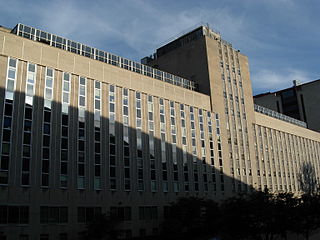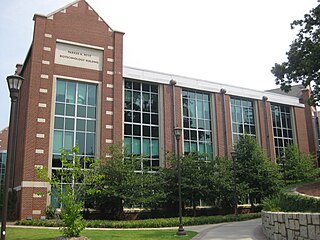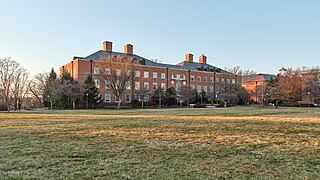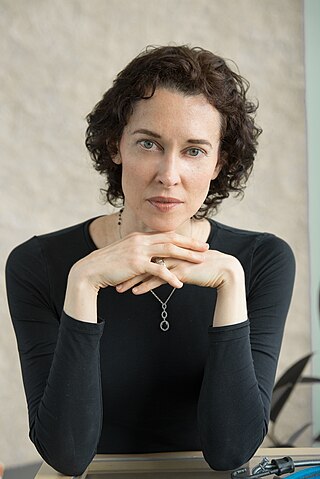Related Research Articles

Case Western Reserve University (CWRU) is a private research university in Cleveland, Ohio. Case Western Reserve was established after Western Reserve University—which was founded in 1826 and named for its location in the Connecticut Western Reserve—and Case Institute of Technology—which was founded in 1880 through the endowment of Leonard Case Jr.—formally federated in 1967.
The Albert Einstein College of Medicine is a private medical school in New York City. Founded in 1953, Einstein operates as an independent degree-granting institution as part of the integrated healthcare Montefiore Health System and also has affiliations with Jacobi Medical Center and Yeshiva University.

Scripps Research, previously known as The Scripps Research Institute (TSRI), is a nonprofit American medical research facility that focuses on research and education in the biomedical sciences. Headquartered in San Diego, California, the institute has over 170 laboratories employing 2,100 scientists, technicians, graduate students, and administrative and other staff.
Translational medicine develops the clinical practice applications of the basic science aspects of the biomedical sciences; that is, it translates basic science to applied science in medical practice. It is defined by the European Society for Translational Medicine as "an interdisciplinary branch of the biomedical field supported by three main pillars: benchside, bedside, and community". The goal of translational medicine is to combine disciplines, resources, expertise, and techniques within these pillars to promote enhancements in prevention, diagnosis, and therapies. Accordingly, translational medicine is a highly interdisciplinary field, the primary goal of which is to coalesce assets of various natures within the individual pillars in order to improve the global healthcare system significantly.

The University of Pittsburgh School of Medicine is a medical school of the University of Pittsburgh, located in Pittsburgh, Pennsylvania. The School of Medicine, also known as Pitt Med, encompasses both a medical program, offering the doctor of medicine, and graduate programs, offering doctor of philosophy and master's degrees in several areas of biomedical science, clinical research, medical education, and medical informatics.
Patrick E. Crago is the Allen H. and Constance T.Ford Professor and Chairman of Biomedical Engineering at Case Western Reserve University in Cleveland, Ohio. Crago is a biomedical engineer currently serving as a Principal Investigator at the Cleveland FES Center.

The Wallace H. Coulter Department of Biomedical Engineering is a department in the Emory University School of Medicine, Georgia Institute of Technology's College of Engineering, and Peking University College of Engineering dedicated to the study of and research in biomedical engineering, and is named after the pioneering engineer and Georgia Tech alumnus Wallace H. Coulter. The graduate program has consistently ranked 2nd in USNWR rankings, while the undergraduate program ranks 1st in USNWR rankings.
Case Western Reserve School of Medicine is the medical school of Case Western Reserve University, a private research university in Cleveland, Ohio. It is the largest biomedical research center in Ohio. CWRU SOM is primarily affiliated with University Hospitals Cleveland Medical Center, Cleveland Clinic, and the MetroHealth System.
Banu Onaral is the H.H. Sun Professor of Biomedical Engineering and Electrical Engineering at Drexel University in Philadelphia, Pennsylvania.

Harvey Franklin Lodish is a molecular and cell biologist, professor at the Massachusetts Institute of Technology (MIT), Founding Member of the Whitehead Institute for Biomedical Research, and lead author of the textbook Molecular Cell Biology. Lodish's research focused on cell surface proteins and other important areas at the interface between molecular cell biology and medicine.
The Center for Study of Gene Structure and Function is a consortium of fifty-three researchers. It is based at Hunter College in Manhattan. It focuses on cross-disciplinary and translational research by promoting dialogue and cooperation among scientists working in diverse biomedical research fields. It is funded by the Research Centers in Minority Institutions (RCMI) program of the National Center for Research Resources(NCRR) of the National Institute of Health (NIH) Since its establishment in 1985, the NIH has awarded the Gene Center over $38 million in federal grants.

The Renaissance School of Medicine (RSOM) is the graduate medical school of Stony Brook University located in the hamlet of Stony Brook, New York on Long Island. Founded in 1971, RSOM is consistently ranked the top public medical school in New York according to U.S. News & World Report. RSOM is one of the five Health Sciences schools under the Stony Brook Medicine healthcare system.

University at Buffalo School of Medicine and Biomedical Sciences, also known as Jacobs School of Medicine and Biomedical Sciences, is a public medical school in the city of Buffalo, New York, at the University at Buffalo. Founded in 1846, it is one of the oldest medical schools in the United States and is the only medical school in Buffalo. It is part of the State University of New York (SUNY) system.

Ravi V. Bellamkonda is an Indian-American biomedical engineer and academic administrator. Since 2021, he has served as Provost and Executive Vice President for Academic Affairs at Emory University in Atlanta, Georgia. Bellamkonda was previously Vinik Dean of the Pratt School of Engineering at Duke University.
Anant Madabhushi is the Donnell Institute Professor of Biomedical Engineering at Case Western Reserve University (CWRU) in Cleveland, Ohio, USA and founding director of CWRU's Center for Computational Imaging and Personalized Diagnostics (CCIPD). He is also a Research Scientist at the Louis Stokes Cleveland Veterans Administration (VA) Medical Center in Cleveland, OH, USA. He holds secondary appointments in the Case Western Reserve University departments of Urology, Radiology, Pathology, Radiation Oncology, General Medical Sciences, Computer & Data Sciences, and Electrical, Computer and Systems Engineering.

The Johns Hopkins University Department of Biomedical Engineering has both undergraduate and graduate biomedical engineering programs located at the Johns Hopkins University in Baltimore, Maryland.
John X. J. Zhang is a tenured professor at Thayer School of Engineering of Dartmouth College, and an investigator in the Dartmouth-Hitchcock Medical Center. Before joining Dartmouth, he was an associate professor with tenure in the Department of Biomedical Engineering at the University of Texas(UT Austin). He received his Ph.D. in electrical engineering from Stanford University, California in 2004, and was a research scientist in systems biology at the Massachusetts Institute of Technology (MIT) before joining the faculty at UT Austin in 2005. Zhang is a Fellow of the American Institute for Medical and Biological Engineering (AIMBE), and a recipient of the 2016 NIH Director's Transformative Research Award.

Jennifer Hartt Elisseeff is an American biomedical engineer, ophthalmologist and academic. She is the Morton Goldberg Professor and Director of the Translational Tissue Engineering Center at Johns Hopkins Department of Biomedical Engineering and the Wilmer Eye Institute with appointments in Chemical Engineering, Biomedical Engineering, Materials Science and Orthopedic Surgery. Elisseeff's research is in the fields of regenerative medicine and immunoengineering.

Jonathan S. Lewin is an American neuroradiologist specializing in medical imaging research with an emphasis on the investigation, development, and translation of new magnetic resonance imaging (MRI) techniques. He is the former executive vice president for health affairs (EVPHA) and executive director of the Woodruff Health Sciences Center for Emory University, and former President, CEO, and chairman of the board of Emory Healthcare. He currently serves as professor of radiology, biomedical engineering, and neurosurgery in the Emory School of Medicine and as professor of health policy and management in the Rollins School of Public Health.
Manu Omar Platt is an American biomedical engineer serving as the director of the NIH Biomedical Engineering Technology Acceleration (BETA) center. He also serves as NIBIB Associate Director for Scientific Diversity, Equity and Inclusion.
References
- ↑ "Department of Biomedical Engineering - Case Western Reserve University". bulletin.case.edu. Retrieved 2015-10-18.
- 1 2 "The Best Biomedical Engineering / Bioengineering Programs in America, Ranked". grad-schools.usnews.rankingsandreviews.com. Retrieved 2016-05-25.
- ↑ "How and when did the rehabilitation engineering center program come into being?". www.rehab.research.va.gov. Retrieved 2016-05-25.
- ↑ "Case Western Reserve University - Advanced Platform Technology Center". www.aptcenter.research.va.gov. Retrieved 2016-05-25.
- ↑ Melzack, R; Wall, P. D (1965). "Pain Mechanisms: A New Theory". Science. 150 (3699): 971–9. Bibcode:1965Sci...150..971M. doi:10.1126/science.150.3699.971. PMID 5320816.
- ↑ Shealy, C. N; Mortimer, J. T; Reswick, J. B (1967). "Electrical inhibition of pain by stimulation of the dorsal columns: Preliminary clinical report". Anesthesia & Analgesia. 46 (4): 489–91. doi: 10.1213/00000539-196707000-00025 . PMID 4952225.
- ↑ "Case Western Reserve University - Ohio History Central". www.ohiohistorycentral.org. Retrieved 2016-05-25.
- 1 2 Gill, Kathy (2009). The History of Biomedical Engineering at Case Western Reserve University 1960 - 2009. Cleveland.
{{cite book}}: CS1 maint: location missing publisher (link) - ↑ Ruggiero, Kate. "Cleveland Rehab Center, Physical Therapy Cleveland, Occupational Therapy Cleveland, Cleveland Rehabilitation Services - The MetroHealth System". www.metrohealth.org. Retrieved 2016-05-25.
- ↑ "Cleveland FES Center | History". fescenter.org. Retrieved 2016-05-25.
- ↑ "Centers - National Institute of General Medical Sciences". www.nigms.nih.gov. Retrieved 2016-05-25.
- ↑ "Coulter Translational Partnership Award in Biomedical Engineering (TP) - Wallace H. Coulter". Wallace H. Coulter. Retrieved 2016-05-25.
- ↑ Center for Computational Imaging and Personalized Diagnostics
- ↑ "Case Western Reserve University | News Center". blog.case.edu. Retrieved 2016-05-25.
- ↑ "Biomedical Engineering Alliance | Department of Biomedical Engineering". engineering.case.edu. Retrieved 2019-02-04.
